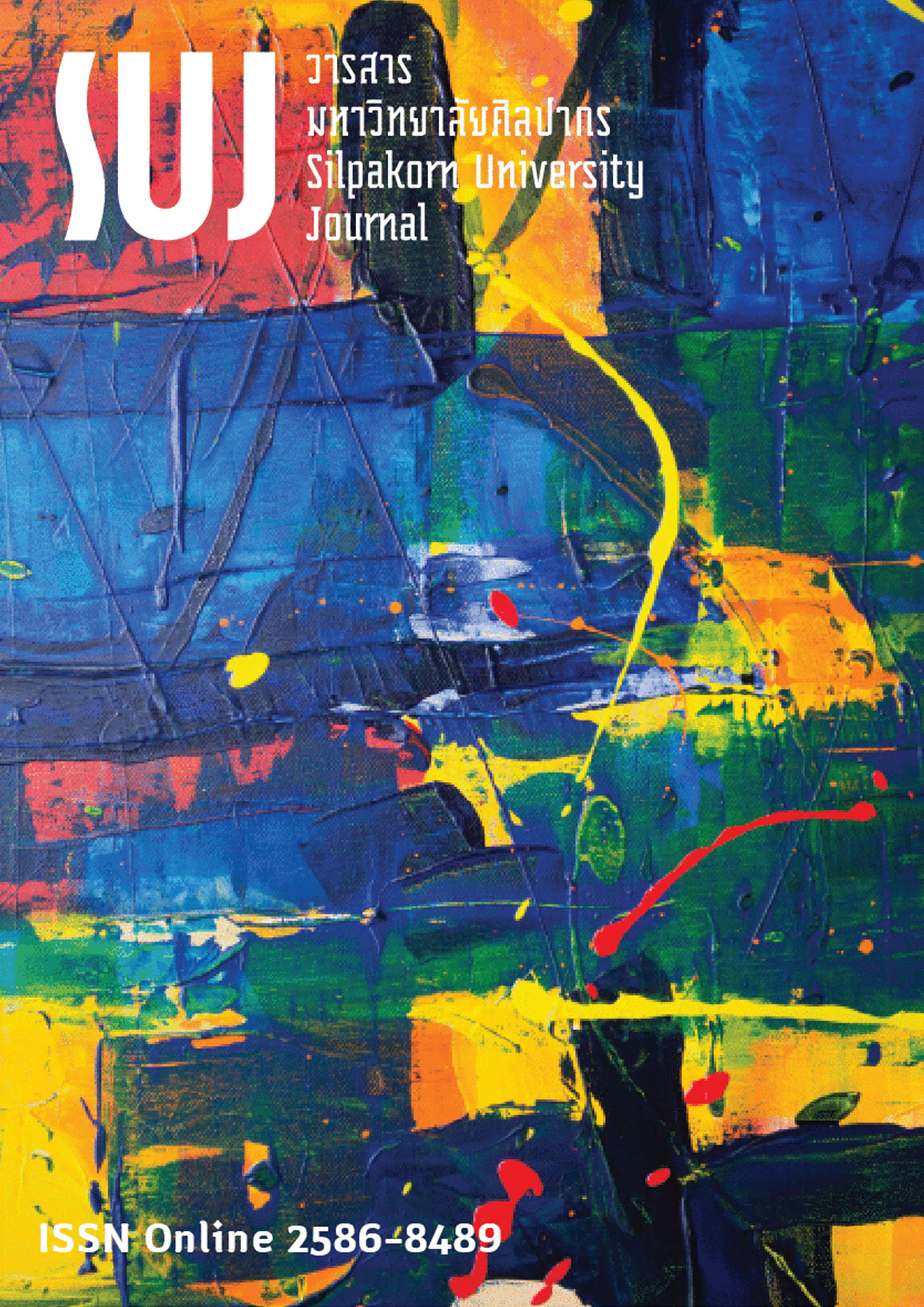พฤติกรรมการค้นคืนและเข้าถึงความรู้วัฒนธรรมผ้าทอกลุ่มชาติพันธุ์ไทยเขมร (Information retrieval behaviors and access to cultural knowledge on Thai-Khmer textiles)
Main Article Content
Abstract
บทความวิจัยนี้มีวัตถุประสงค์เพื่อศึกษาพฤติกรรมการค้นคืนและเข้าถึงความรู้วัฒนธรรมผ้าทอกลุ่มชาติพันธุ์ไทยเขมร เป็นงานวิจัยเชิงคุณภาพ ผู้ให้ข้อมูลหลัก คือ 1) อาจารย์ 2) นักวิชาการ 3) ผู้ประกอบการธุรกิจ และ 4) นักศึกษา จำนวนทั้งสิ้น 29 คน ในพื้นที่จังหวัดบุรีรัมย์ สุรินทร์และศรีสะเกษ เครื่องมือวิจัย คือ แบบสัมภาษณ์ โดยเลือกผู้ให้ข้อมูลหลักแบบบอกต่อ ผลการศึกษาพบว่า 1) ด้านบริบทการค้นคืนความรู้ วัตถุประสงค์การค้นคืนความรู้ อาจารย์ค้นคืนเพื่อสอน วิจัย และเป็นวิทยากร นักวิชาการค้นคืนเพื่อส่งเสริมและอนุรักษ์วัฒนธรรมผ้าทอ ผู้ผลิตผ้าทอค้นคืนเพื่อผลิตและสร้างอัตลักษณ์ผ้าทอ ผู้ประกอบการธุรกิจค้นคืนเพื่อพัฒนาผลิตภัณฑ์ นักศึกษาค้นคืนเพื่อทำรายงานหรือภาคนิพนธ์ เนื้อหาค้นคืนความรู้เป็นเนื้อหาเรื่องลวดลายและประเภทผ้าทอ แหล่งสารสนเทศที่ค้นคืน คือ แหล่งสารสนเทศอินเทอร์เน็ต 2) ด้านกลยุทธ์ค้นคืนความรู้ ใช้เทคนิคค้นคืนความรู้วัฒนธรรมผ้าทอมากกว่า 1 วิธี เช่น ค้นจากคำสำคัญ (keyword) ประเด็นหรือหัวข้อ (topic) การประเมินผลการค้นคืนจากชื่อเรื่อง หัวข้อและรายละเอียดของเนื้อหาและอ้างอิงจากแหล่งที่มาที่น่าเชื่อถือ และ 3) ปัญหา อุปสรรค และข้อเสนอแนะการค้นคืนความรู้ คือ เครื่องมือช่วยค้นคืนแสดงผลการค้นไม่ครอบคลุมเนื้อหา ดังนั้นควรพัฒนาเครื่องมือการค้นคืนที่จัดกลุ่มเนื้อหาแสดงให้เห็นโครงสร้าง ความสัมพันธ์ของเนื้อหา มีคำศัพท์มาตรฐานสากล คำศัพท์ของกลุ่มชาติพันธุ์ที่สามารถค้นคืนได้จากจุดเดียว
This study aims to explore the information retrieval behaviors and access to cultural knowledge on Thai-Khmer textiles. This research is qualitative research. Twenty-nine informants who were selected by the snowball sampling method were lecturers, academics, entrepreneurs, and university students from Buriram, Surin, and Sisaket provinces. The research tool was an interview form. It was found that 1) on aspects of the information retrieval behaviors, the lecturers retrieved information to teach, research, and train; the academics retrieved information to promote and conserve textile culture; the weavers gathered information to produce and create a woven fabric identity, the entrepreneurs retrieved information to develop products; and the university students retrieved them for a report or thesis. The content of knowledge retrieval was patterns and types of woven fabrics. The source of information retrieved was the internet, 2) on the aspects of retrieval strategies, the target groups applied more than one strategy to retrieve the information, such as searching by keywords, issues or topics, evaluating the retrieval of the title, topic and content, and citing from reliable sources, and 3) the problems and recommendations for information retrieval were as follows: information retrieval tools did not cover all contents; therefore, these tools should be developed so that they were able to categorize each topic, demonstrate the structure of contents, and provide universal and ethnic terminology in a single search.
Downloads
Article Details

This work is licensed under a Creative Commons Attribution-NonCommercial-NoDerivatives 4.0 International License.
References
Boonpok, Duangden. (2019). Identity and symbols of the ethnic Khmer in Thailand’s silk weaving cloths (อัตลักษณ์และสัญลักษณ์ของผ้าไหมพื้นเมืองกลุ่มเขมรถิ่นไทย). Faculty of Humanities and Social Science Thepsatri Rajabhat University Journal, 10(1): 91-102.
Chaichuay, Witsapat. (2015). The guidelines for textiles collection information management in Ubonratchathani national museum (แนวทางการจัดการสารสนเทศคลังสะสมผ้าในพิพิธภัณฑสถานแห่งชาติอุบลราชธานี). Veridian E-Journal, Silpakorn University (Humanities, Social Sciences and Arts), 8(2): 2422-2437.
Hiangrat, Praima. (2019). Information behavior of undergraduate students at Rajabhat Mahasarakham Universities (พฤติกรรมสารสนเทศของนักศึกษามหาวิทยาลัยราชภัฏมหาสารคาม). Chophayom Journal, 30(2): 241-248.
Hintow, Bussaba, & Thongyaem, Yanyongvorakorn. (2019). Knowledge management on local wisdoms: Case study of OTOP of Ban Muanghorm textile, Wangthong district, Phitsanulok province (การจัดการความรู้ภูมิปัญญาท้องถิ่น : ศึกษากลุ่มผลิตสินค้า OTOP ผ้าทอบ้านม่วงหอม อำเภอวังทองจังหวัดพิษณุโลก). The Golden Teak: Humanity and Social Science Journal, 25(1): 55-64.
Jeewattana, Somsak, & Pattarasrejerakul, Chalida. (2015). Developing the hand - woven Thai silk database system for community enterprises in Buriram province (การพัฒนาระบบฐานข้อมูลผ้าไหมทอมือของกลุ่มวิสาหกิจชุมชน จังหวัดบุรีรัมย์). Journal of Research and Development Buriram Rajabhat University, 10(1): 59-67.
Kruaysawat, Napassakorn, Manmart, Lampang, & Kabmala, Malee. (2018). Users’s behavior in accessing and using key words to retrive business and economic information (พฤติกรรมการเข้าถึงสารสนเทศและการใช้คำศัพท์ในการสืบค้นทรัพยากรสารสนเทศ สาขาบริหารธุรกิจและเศรษฐศาสตร์ของผู้ใช้). Journal of Information Science, 36(1): 69-108.
Keawban, Sawas, Prayongtrap, Yubha, & Udomtawi, Kachanipha. (2019). The wisdom of original silk weaving of Keayai community in Muang district, Surin province (ภูมิปัญญาการทอผ้าไหมลายโบราณของชุมชนบ้านแกใหญ่ อำเภอเมือง จังหวัดสุรินทร์). Academic MCU Buriram Journal, 4(1): 71-85.
Klangrit, Suriya, Sirippaprapagon, Yasothara, & Mingtaisong, Putsorn. (2020). “Niak-Naka” An original pattern on Mudmee silk of Thai-Khmer people in Surin province (“เนี๊ยะ-นาค” ลวดลายดั้งเดิมบนผืนผ้าไหมของกลุ่มคนไทยเชื้อสายเขมรสุรินทร์). Parichart Journal Thaksin University, 33(3): 20-36.
Leckie, G. J., Pettigrew, K. E., & Sylvain, C. (1996). Modeling the information seeking of professionals: A general model derived from research on engineers, health care professionals, and lawyers. The Library Quarterly, 66(2): 161-193.
Muenjanchoey, Renu. (2015). Cultural capital for Thai Song Dam’s development in Nakhon Pathom province (ทุนวัฒนธรรมเพื่อการพัฒนากลุ่มชาติพันธุ์ไทยทรงดำในจังหวัดนครปฐม). Veridian E-Journal, Silpakorn University (Humanities, Social Sciences and Arts), 8(2): 231-247.
Panommit, Pattara, Arayaphan, Watsaporn, & Julrode, Phichete. (2017). Retrieving and accessing to the knowledge of Lanna textiles from information resources in the upper northern Thailand (การค้นคืนและเข้าถึงความรู้ด้านผ้าล้านนาของแหล่งสารสนเทศด้านผ้าล้านนาในเขตภาคเหนือตอนบน). Veridian E-Journal, Silpakorn University (Humanities, Social Sciences and Arts), 10(3): 1545-1559.
Pawinun, Prapat, & Tongkaew, Kanyarat. (2018). Digital information searching and seeking of graduate students of Law faculty, Ramkhamhaeng university (การแสวงหาและการสืบค้นสารสนเทศดิจิทัลของนักศึกษาระดับบัณฑิตศึกษา คณะนิติศาสตร์ มหาวิทยาลัยรามคำแหง). Journal of Humanities and Social Science Valaya Alongkorn, 13(3): 174-185.
Phayakprakhon, Maywadee, Supasetsiri, Prit, Inchan, Noppadol, & Nopudomphan, Kittikorn. (2016). Folk handweaving silk in Surin province (ผ้าไหมทอมือพื้นบ้านในเขตพื้นที่จังหวัดสุรินทร์). Institute of Culture and Arts Journal Srinakharinwirot University, 18(1): 94-105.
Pholphaengkwa, Ruchira, Kultawatwong, Sajee, Chinnapha, Puntipha, Chantopas, Kiattiporn, Ruthasothorn, Preecha, Sunthonsiriphong, Nittaya, Techapairo, Thiti, Kaowongthong, Nantapa, & Torsahakulcharoen Ploypailin. (2017). The local wisdom management relating the cultural arts of on Ban Punna’s group producing natural-day fabric for the sustainable development, Sawangdaendin district, Sakon Nakhon province (การจัดการความรู้ภูมิปัญญาท้องถิ่นของกลุ่มทอผ้าย้อมสีธรรมชาติบ้านพันนา อำเภอสว่างแดนดิน จังหวัดสกลนคร เพื่อการพัฒนาที่ยั่งยืน). Santapol College Academic Journal, 3(1): 128-138.
Premsrirat, Suwilai. (2005). Langnagrs and ethnic group in Thailand (แผนที่ภาษาของกลุ่มชาติพันธุ์ต่าง ๆ ในประเทศไทย). Journal of Thai Traditional and Alternative Medicine, 3(2): 41-51.
Sittirit, Chakrit. (2016). Tangible and intangible: Similarities among the diversities of the cultural heritage (จับต้องได้ - จับต้องไม่ได้ : ความไม่หลากหลายในความหลากหลายของมรดกทางวัฒนธรรม). Journal of Humanities and Social Sciences Suratthani Rajabhat University, 8(2): 141-160.
Tukphimai, Sangwan, Wantrong, Sarapee, & Goonrat, Santhana. (2017). Information Knowledge of Weavers to Promote the Potential of Hand-Woven Cloth in Surin Province (การรู้สารสนเทศของช่างทอผ้า เพื่อส่งเสริมศักยภาพผ้าทอมือในจังหวัดสุรินทร์). Surin: Surindra Rajabhat University.
United Nations Educational, Scientific and Cultural Organization. (2020). Basic Texts of the 2003 Convention for the Safeguarding of Intangible Cultural Heritage. Paris: UNESCO.
Wilson, T. D. (1999). Models in information behavior research. Journal of Documentation, 55(3): 249-270.


